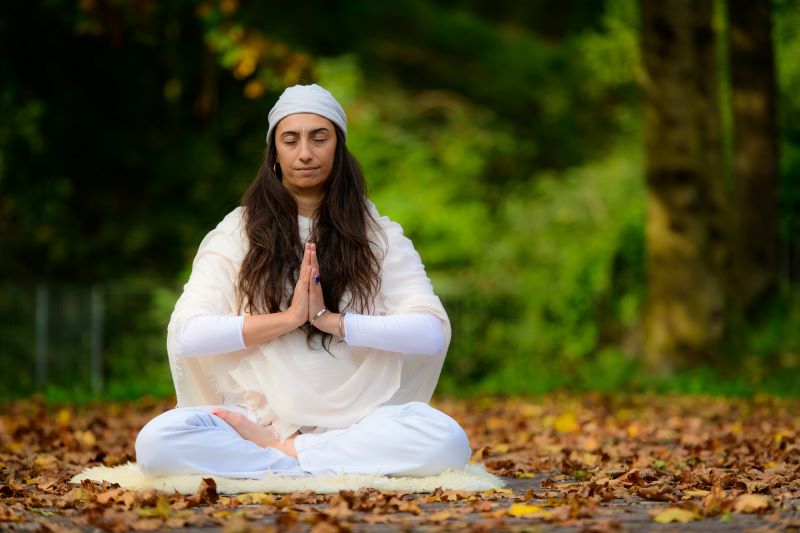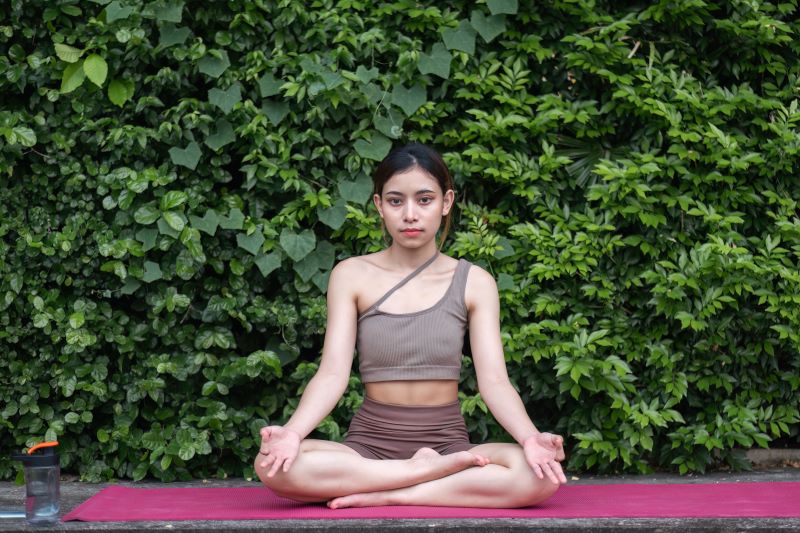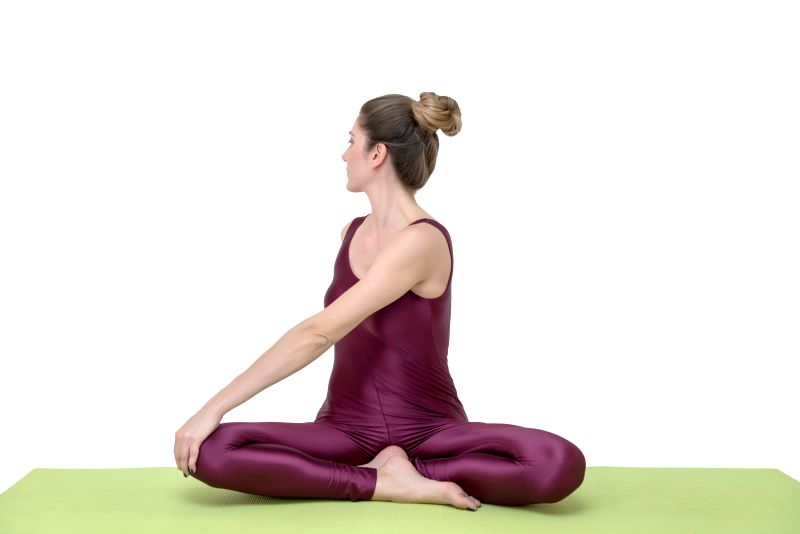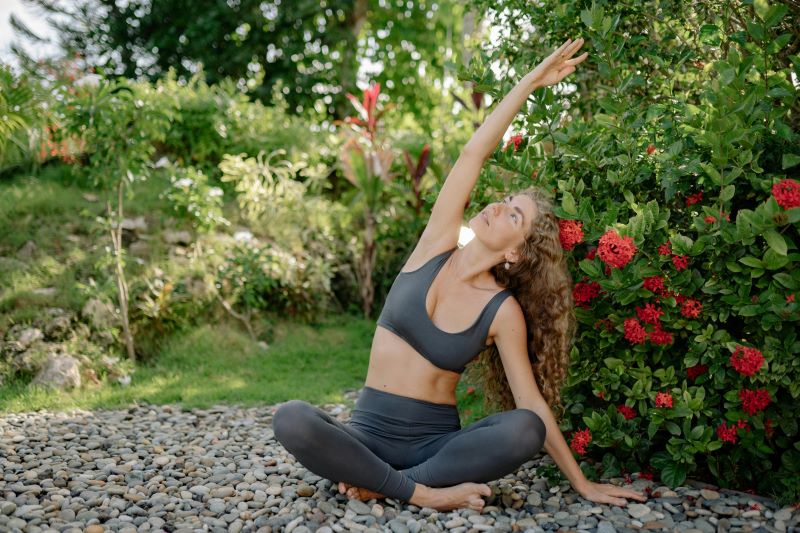13 Health Benefits of Ardha Padmasana & How to Do It?

Yoga is beneficial for different lifestyle disorders as it helps to boost your body’s natural healing process. You can do different yoga postures for different parts of your body. However, the most crucial aspect of yoga is retaining the body’s flexibility.
Ardha Padmasana is a notable posture in this regard. It is highly beneficial for the flexibility of lower body parts, including the spine and muscles. Scroll down to learn more about the benefits of Ardha Padmasana.

Table of Contents

What is Ardha Padmasana?
In Sanskrit, ‘Ardha’ means half, ‘Padma’ means lotus, and ‘asana’ means posture. Therefore, the posture is like a Half Lotus. In this yoga pose, you must sit straight by folding your legs and keeping your hands on your knees. Ensure that your ankles touch the inner corner of your thighs during the posture.
Regularly performing the Half Lotus pose helps to strengthen the neck and spine's flexibility. It also corrects postural issues with the shoulders and neck. The pose is mainly for meditation but has several other benefits. Read on to learn about the benefits of Ardha Padmasana.
How to Perform Ardha Padmasana (Half Lotus Pose)?

Ardha Padmasana is quite an easy yet effective pose for every yoga practitioner. The step-by-step guide on how to do this yoga is as follows:
Step 1: Sit on a yoga mat or flat surface with ease
Step 2: Bring your right foot on the top of your left calf by using your hands
Step 3: Take your right foot on the top of your left thigh as much as you can and try to touch your left hip joint
Step 4: Bend your left leg and put it under the right one
Step 5: Keep your head and spine straight and rest your hands on your knees
Step 6: Close your eyes and try to concentrate
Step 7: Stay in this pose for 1 minute
Step 8: Release both your legs and repeat the same with the other leg
Step 9: After completing the steps, lie down and rest your body in the pose of Shavasana.
13 Health Benefits of Ardha Padmasana
This pose opens up the hips and reduces strain on the knees. The benefits of Ardha Padmasana are as follows:
1. Great to Start Your Meditation Journey
Ardha Padmasana is a traditional yoga pose for meditation. The posture relaxes your body and helps you focus on your inner mind. Therefore, it will help freshen up your mind and boost positivity.
2. Boosts Cognitive Power
Ardha Padmasana helps boost cognitive power. This posture increases memory capability and helps connect the body and mind. Therefore, people suffering from concentration problems practice this posture for compelling results.
3. Helpful for Losing Weight
Ardha Padmasana is well-known for boosting metabolism, which is beneficial for weight loss. Therefore, if you lose weight, add Ardha Padmasana to your daily exercise routine and get effective results.
4. Relieves Stress and Anxiety
Ardha Padmasana is an effective posture for calming your body. It helps your brain secrete mood-boosting hormones, which can help you overcome anxiety and depression. However, you need to practice it daily to get effective results.
5. Improves Body Flexibility
Ardha Padmasana helps enhance the flexibility of the spine and neck. It can also naturally treat faulty neck and shoulder posture. Furthermore, it helps make your lower body muscles flexible and toned by reducing excess fat from these areas.
6. Alleviates Menstrual Discomfort
Ardha Padmasana can help relieve menstrual discomfort by gently stretching the pelvic area and promoting relaxation in the abdominal muscles. Do the pose regularly to relieve cramps during periods.
7. Promotes Spiritual Awareness
As a meditative posture, Ardha Padmasana can deepen one's spiritual practice by fostering introspection, self-awareness, and a sense of connection to the inner self. Breathing deeply in the pose makes one feel more aware.
8. Increases Concentration
Holding Ardha Padmasana requires focus and concentration, which can help improve mental clarity and enhance cognitive function. Holding the pose for 2-3 minutes per day benefits the concentration power of the mind.
9. Enhances Blood Circulation
This pose increases blood flow to the lower body, improving circulation and delivering oxygen and nutrients to the muscles and organs. Sitting still in Ardha Padmasana ensures a steady blood flow to the lower region of the body.
10. Stimulates the Nervous System
The gentle pressure applied to the lower spine and pelvic region in Ardha Padmasana stimulates the sacral chakra and the parasympathetic nervous system, promoting relaxation and rejuvenation.
11. Opens the Hips
This pose stretches and opens the hip flexors, groin, and thighs, alleviating hip stiffness and tension and improving flexibility and mobility. Regularly performing this pose can also make you more flexible.
12. Strengthens the Back
Ardha Padmasana strengthens the back muscles by encouraging proper posture and alignment. It reduces the risk of back pain and improves spinal health. The pose demands a straight back.
13. Calms the Mind
Practising Ardha Padmasana helps calm the mind and reduce stress and anxiety by focusing on the breath and creating balance and tranquillity. Sit in Ardha Padmasana for a few minutes daily for a calm mind.
The Mudras of Ardha Padmasana (Half Lotus Pose)
Ardha Padmasana can be enhanced by incorporating some mudras. These hand gestures direct the body’s energy flow to the correct places and help rejuvenate the body and mind.
1. Anjali Mudra (Prayer Gesture)

In Ardha Padmasana, the Anjali Mudra brings the palms together at the heart centre. This gesture symbolises unity and respect, connecting the practitioner to their inner self and expressing gratitude.
Benefits of Anjali Mudra: Anjali Mudra helps alleviate mental stress and anxiety and helps one become more focused.
2. Gyan Mudra (Knowledge Gesture)

This mudra in Ardha Padmasana, which involves the index finger touching the thumb, enhances concentration and sharpens the mind. It represents the connection between individual consciousness and universal consciousness.
Benefits of Gyan Mudra: Gyan Mudra promotes blood flow to the brain and increases nutrient flow, improving brain activity.
3. Dhyana Mudra (Meditation Gesture)

The Dhyana Mudra fosters inner peace and tranquility during Ardha Padmasana. It involves placing the hands on the lap, palms facing upwards, with the right hand resting on the left and thumbs gently touching. This posture encourages focus and contemplation and aids in deep meditation.
Benefits of Dhyana Mudra: Dhyana Mudra helps control stress levels and keep anxiety and depression at bay by building intuition.
4. Abhaya Mudra (Gesture of Fearlessness)
In Ardha Padmasana, the Abhaya Mudra is expressed by raising the right hand to shoulder level with the palm facing outward. This gesture signifies protection, peace, and the dispelling of fear, allowing practitioners to embrace their practice with courage and confidence.
Benefits of Abhaya Mudra: Abhaya Mudra helps protect against evil energies and is a sign of peace and harmony.
Types of Ardha Padmasana
1. Ardha Padmasana with Forward Fold

Sit in Ardha Padmasana and bend forward, trying to touch your forehead with the floor. Adding a forward fold intensifies the stretch in the hips, thighs, and lower back. It also stimulates the abdominal organs and promotes relaxation.
2. Ardha Padmasana Variation with Twist

Sit in Ardha Padmasana and twist to one side by holding the knee with the opposite hand. Incorporating a twist into Ardha Padmasana involves gently rotating the torso towards the bent knee.
3. Ardha Padmasana Variation with Side Bend

Sit in Ardha Padmasana, stretch your hand up, and bend to one side while supporting your body with the other hand. This variation stretches the sides of the body, opens the chest and shoulders, and improves lateral flexibility. It also enhances breathing capacity and promotes a sense of balance and alignment.
4. Ardha Padmasana Variation with Arm Balance

Sit in Ardha Padmasana and raise your body, balancing it on your palms. Adding an arm balance to Ardha Padmasana challenges stability and core strength while further engaging the upper body muscles.
Things to Know Before Doing Ardha Padmasana Yoga
Ardha Padmasana requires some prep before attempting it. Here are some essential things to know before attempting Ardha Padmasana in yoga:
- Flexibility: Before attempting Ardha Padmasana (Half Lotus Pose), ensure that your hips, knees, and ankles are sufficiently flexible. Tightness in these areas can lead to strain or injury during the pose.
- Warm-up: It's essential to warm up your body before practising Ardha Padmasana. Engage in gentle stretches targeting the hips, thighs, and lower back to prepare these areas for the pose.
- Alignment: Pay attention to proper alignment while performing Ardha Padmasana. Maintain a straight spine and avoid rounding the back to prevent strain on the spine and lower back.
- Gradual Progression: If you're new to Ardha Padmasana or have limited flexibility, start with more accessible variations or preparatory poses such as Sukhasana (Easy Pose) or Baddha Konasana (Bound Angle Pose) before attempting the Half Lotus Pose.
- Breathing: While in Ardha Padmasana, focus on deep, steady breathing to enhance relaxation and promote mindfulness. Avoid holding your breath, and let the breath flow naturally throughout the pose.
- Comfort: Listen to your body and go as far into the pose as comfortable. Discomfort or pain is a sign to ease off or modify the pose accordingly. Use props like cushions or blocks for support if needed.
- Avoid Force: If you experience discomfort or resistance, avoid forcing your body into Ardha Padmasana. Instead, gently coax your body into the pose over time, respecting its limits and gradually increasing flexibility.
- Consistency: Consistent practice is critical to improving flexibility and mastering Ardha Padmasana. Include it regularly in your yoga routine while being patient with your progress.
- Modifications: Don't hesitate to modify Ardha Padmasana to suit your needs and abilities. Use props or variations to make the pose accessible and enjoyable, focusing on its benefits for your body and mind.
How Long to Sit in Ardha Padmasana?
The duration of holding an Ardha Padmasana pose can vary. Here's how long beginners, intermediate-level practitioners, and advanced practitioners can aim to hold it:
- Beginners: For beginners, start by sitting in Ardha Padmasana for about 1-3 minutes per session. Focus on maintaining proper alignment and gradually increase the duration as your flexibility improves.
- Intermediate Level: Intermediate practitioners can aim to hold Ardha Padmasana for 3-5 minutes per session. This allows for deeper stretching and relaxation while building endurance and stability in the pose.
- Advanced Level: Advanced practitioners may sit in Ardha Padmasana for 5-10 minutes or more, depending on their comfort and flexibility. Holding the pose for longer durations can enhance hip opening benefits, improve focus, and deepen the meditative experience.
Practise regularly to become comfortable with this pose. However, always respect your body's limits and avoid pushing into discomfort or strain.
Risks of Overdoing Ardha Padmasana
Although there are many benefits to performing Ardha Padmasana regularly, a few risks are involved if done incorrectly. Here are some risks associated with overdoing Ardha Padmasana:
- Knee Strain: Overdoing Ardha Padmasana can put excessive pressure on the knees, leading to strain or injury, especially if the hips are not flexible.
- Hip Discomfort: Pushing beyond your limits in Ardha Padmasana can cause discomfort or strain in the hip joints, particularly if you force the knees down or the foot into the hip crease.
- Lower Back Pain: Overarching the lower back or rounding the spine excessively while attempting Ardha Padmasana can strain the lower back muscles.
- Ankle Strain: Forcing the foot into the hip crease in Ardha Padmasana without proper ankle flexibility can strain the ankle joint or surrounding muscles.
- Nerve Compression: Overdoing Ardha Padmasana may compress the nerves around the hips and thighs, leading to numbness, tingling, or discomfort in the legs.
- Impact on Circulation: Holding Ardha Padmasana for a long time, especially if done incorrectly or with excessive force, can impede blood flow to the legs.
- Strain on Connective Tissues: Overstretching in Ardha Padmasana can strain the ligaments, tendons, and connective tissues around the hips, knees, and ankles.
Understanding your limits and attempting this yoga pose with caution will be helpful for those practising the Ardha Padmasana. Yield the benefits by avoiding the above.
3 Tips for Practicing Ardha Padmasana
If you are a beginner, you may lack proper knowledge of performing Ardha Padmasana correctly and make mistakes. However, to avoid these mistakes, you can follow the below-mentioned tips:
- Breathe Normally: You need to perform this posture for 1 minute, so do not try to hold your breath during the process. Instead, you should breathe deeply through your nose throughout the process to attain meditation’s benefits.
- Do not Force Yourself: Ardha Padmasana's main aim is to calm your body and mind. Therefore, you need to relax while practising. Wait until you have complete expertise in the pose, and do not force your body to fit into it.
- Switch your Legs: Switching your legs is important to complete this yoga posture. You should bend both legs for an equal amount of time to get the maximum health benefits. Further, if you do not switch your legs, it will disrupt body parity.
What are the Precautions and Contraindications of Ardha Padmasana?
You should consider these precautions and contraindications to practise Ardha Padmasana safely and benefit from it.
Do not perform if you have chronic knee pain
Avoid this posture if you have any hip injury
Stop practising if you feel any pain during the process
If you have sciatica, do not perform it
Surgical patients should avoid this yoga posture
Avoid it if you have disc disorders.
Who Should Avoid Doing Ardha Padmasana?
To avail yourself of the complete benefit of Ardha Padmasana, it's essential to do it every day correctly. However, here are some individuals who should avoid doing Ardha Padmasana:
- Individuals with Knee Injuries: Those with knee injuries or conditions like ligament tears, meniscus tears, or osteoarthritis should avoid Ardha Padmasana. This pose stresses the knees and can increase knee issues or cause further injury.
- Hip Problems: Individuals with hip injuries, pain, or impingement should avoid Ardha Padmasana. The pose requires deep hip flexion and external rotation, which can aggravate hip discomfort or strain the hip joints.
- Ankle Issues: People with ankle injuries, instability, or limited mobility should avoid Ardha Padmasana. The pose involves placing the foot in a position that requires flexibility and stability in the ankle joint.
- Recent Surgery: Those who have undergone recent surgery on the knees, hips, or ankles should avoid Ardha Padmasana until they have fully recovered and received clearance from their healthcare provider.
- Pregnant Women: Women should avoid Ardha Padmasana, especially in the later stages. The pose can compress the abdomen and pelvic region, potentially causing discomfort or affecting blood circulation to the uterus and foetus.
- High Blood Pressure: Individuals with uncontrolled high blood pressure should avoid Ardha Padmasana, as the pose can potentially elevate blood pressure further due to the deep breathing and compression of the abdomen.
- Beginners with Limited Flexibility: People with limited flexibility in the hips, knees, or ankles should approach Ardha Padmasana with caution or avoid it altogether until they have developed sufficient flexibility through other yoga poses and exercises.
What are the Easy Modifications of Ardha Padmasana?
If you are a beginner and finding it difficult to perform Ardha Padmasana initially, you should try the following modifications.
- Sit by a Wall: If you can not keep your body straight during the posture, you can easily sit beside a wall and keep your back straight. Initially, this will help you to attain perfection.
- Use a Blanket: If you find touching your legs to your hip crease difficult, place 2 folded blankets under your hip to heighten your body. Further, you can also place soft blankets under your knees if you feel pain.
This guide on the benefits of Ardha Padmasana will help you understand its advantages and how to use it perfectly. Further, you will also know the precautions and modifications to perform the posture perfectly. You should perform Ardha Padmasana regularly to eliminate tiredness and positively energise your body and mind.














